Cellular disruption and its influence over the drying kinetics of brewer´s spent yeast biomass
DOI:
https://doi.org/10.4025/actascitechnol.v42i1.48792Keywords:
autolysis; freeze-drying kinetics; mathematical models; yeast biomass.Abstract
Spent yeast biomass is one of the residues of brewing. It is specifically the second-largest residue from brewing industry. Most of the spent yeast is sold at low prices, or disposed as waste or used as animal feed. Spent yeast biomass is predominantly composed of proteins, and it has a high biological value, being an excellent source of high-quality protein, comparable in value with soy protein. Therefore, spent yeast biomass has great potential for use in foodstuffs for human consumption. The objective of this work was to evaluate the influence of cell rupture over the drying kinetics of spent yeast biomass using mathematical models (Lewis and Page). Also, to verify the influence of cell rupture method over the amount of protein. The cellular rupture was performed by two methods (chemical method and physical method: ultrasound). The drying process was performed by freeze-drying, and the parameters of the models were obtained using the non-linear regression (Generalized Reduced Gradient Nonlinear Optimization Code). Mathematical models of drying kinetics showed a strong correlation with the experimental data, R² > 0.96. The disruption process did not significantly affect the drying time and protein content. But the cellular autolysis improves the protein digestibility since the proteins will be totally available to the digestive enzymes and also increase the bioavailability of nutrients.
Downloads
Downloads
Published
How to Cite
Issue
Section
License
DECLARATION OF ORIGINALITY AND COPYRIGHTS
I Declare that current article is original and has not been submitted for publication, in part or in whole, to any other national or international journal.
The copyrights belong exclusively to the authors. Published content is licensed under Creative Commons Attribution 4.0 (CC BY 4.0) guidelines, which allows sharing (copy and distribution of the material in any medium or format) and adaptation (remix, transform, and build upon the material) for any purpose, even commercially, under the terms of attribution.
Read this link for further information on how to use CC BY 4.0 properly.











8.png)




